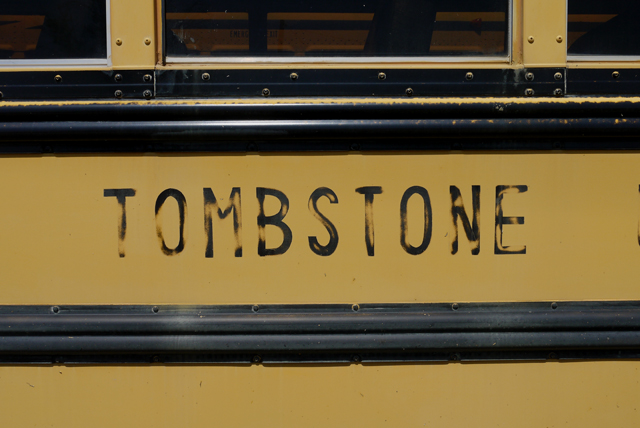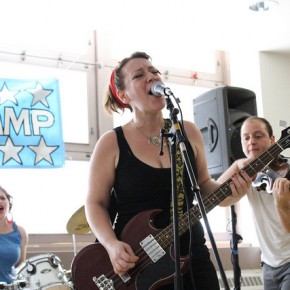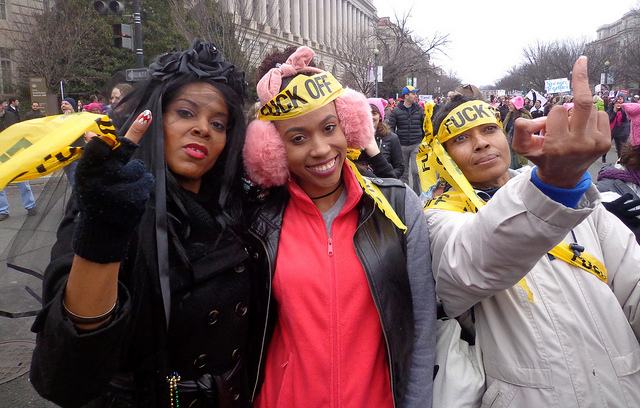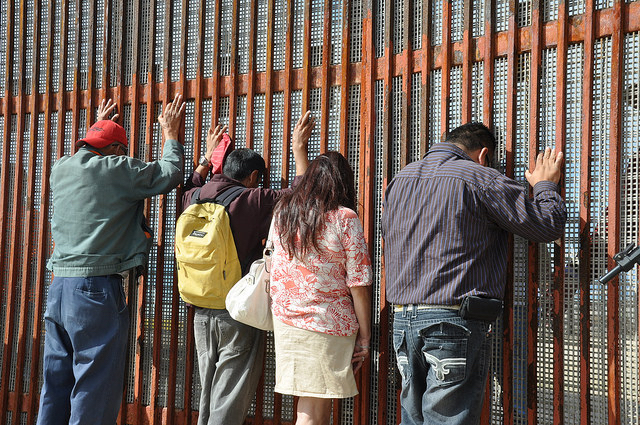“I am just glad there isn’t a cactus on the cover.” Justin St. Germain is in the Tap Room of Tucson’s historic Hotel Congress, discussing his stunning new memoir Son of a Gun. At the time, I think he is simply expressing the saguaro fatigue that afflicts longtime residents of the Sonoran Desert. Images of the tree-sized cactus are stamped on everything imaginable. But when I drive through Tombstone a month later, I realize my mistake: even though it’s only barely more than an hour’s drive to the southeast, there’s not a cactus to be seen.
And that distinction clearly matters to St. Germain because, as close as Tombstone and Tucson may seem to be on the map, they are worlds apart for him. Tombstone is where his mother moved to start over; Tucson is where he was forced to do so. Tombstone is where he came of age, a small town forced to reenact its violent past over and over in order to stay alive; Tucson is where he started to break free of that legacy, finding a way to express his feelings with words instead of the guns favored back home.
We all have places in our lives that feel haunted, places we avoid in our waking life, but are compelled to visit in our dreams. Tombstone functions that way for St. Germain. Even if his mother were still alive, the way the town treated her would have left him bitter. The fact that she was murdered on its outskirts, after a series of bad relationships had transformed her into an outcast, makes it impossible to forgive and forget.
Son of a Gun is many things, not all of which are apparent when you begin reading it: a diary of grieving; a dissection of working-class masculinity; a detective novel turned inside out. But it’s Tombstone that binds the book together, a symbol so potent that it threatens to take over whatever it touches. That St. Germain manages to show what it’s like to live there without succumbing to the town’s world-famous mythology is a testament to his strength, as both a writer and a person. He does make it clear, though, how much this resistance cost him.
Late in Son of a Gun, he describes one of the research trips back to Arizona he made while writing it. Eventually, his girlfriend at the time comes down from the San Francisco Bay Area to join him. “Laura’s never been to Arizona and wants to do the tourist thing, but I’ve always hated tourists, how they gather in herds where their guidebooks tell them to, saying it’s not what they expected.” Still, when she prods him to take her to Tombstone, he reluctantly consents.
“Thirty miles away, I’m already throttling the steering wheel, breathing fast. This was a bad idea. I could pull over and turn around, but what would I tell Laura?” In spite of his misgivings, he presses on. “This county is a minefield of memories. Finally we top a rise and there it is, on a plateau in the middle of the valley, a cluster of low buildings ringed by brown hills: Tombstone. It’s not much to look at, and disappoints almost everybody at first sight. The town’s early settlers wrote east to report its ugliness: it hasn’t gotten prettier since.”
These words keep coming back to me as I approach Tombstone for the first time. Maybe it’s because I’m making the trip later in the summer. Maybe it’s because this year’s Monsoon keeps getting stuck in Cochise County while I’m forced to water the plants back in Tucson on a daily basis. Maybe it’s simply that the place holds no memories for me. But all I see, at first, is beauty.
I’ve opted to turn off Interstate 10 a little early, before Benson, onto the road that heads to the military base town of Sierra Vista. Although it’s a slightly longer route, I want to cross the San Pedro River where I can properly appreciate that rarest of desert sights, water that runs the whole year round. I like to think of late summer as Tucson’s “green” season, after the desiccated plant life of June has been reanimated by the Monsoon rains. The minute I leave the freeway, though, it’s clear that this part of the Chihuahuan high desert is far greener right now. I stop right before the bridge to take a longer look at the river, marveling at the sort of view I once took completely for granted growing up in on the Eastern Seaboard.
One of the questions Son of a Gun raises is why a restless, strong-willed woman like St. Germain’s mother — someone who had volunteered to train as a paratrooper — would have ended up living in a place as claustrophobic as Tombsone. After all, the town markets itself as a “dead-end”, the sort of place where nobody stays by accident. Taking in the simple splendor of the river basin, though, I can see why it would be hard to leave.
Once I’ve made it to Tombstone proper, however, I also see why a person might want to. In one sense, the town is like so many across the United States: too small to sustain a healthy economic base in the age of global travel and too far from a big city to be reborn as a commuter suburb. When a town like this has a semblance of historical character, it can become a tourist destination for weekend travelers. And if it has a past as storied as Tombstone’s, it has the chance to develop into a much bigger draw, the kind of destination that people will make a substantial detour for.
Such a fate is surely better than death. Tombstone survived; most other towns of the Wild West did not. But it’s hard not to perceive the way the town’s identity wears on its inhabitants, particularly on a weekday afternoon in the middle of summer, when the millions of people who descend on Arizona in winter have long since returned to the cooler locales they consider their true homes. The insistence that Tombstone is “too tough to die”, broadcast on signs, T-shirts and even trash cans wherever you look, is the sort of boast that requires constant backing up. And it’s impossible to forget — reminders are constant — that this survival depends on a celebration of violence.
As the title of his book makes clear, St. Germain is keenly aware of this paradox. To have grown up in Tombstone is to have grown up with the knowledge that guns are a source of both life and death. Yet this doesn’t stop him from reframing Tombstone’s greatest claim to fame in a way that would give many of its inhabitants pause. “A lot of factors caused the Gunfight at the O.K. Corral — rivalries and rumormongering, broken deals and betrayals, business and political tensions — but in the most literal sense it was a fight over gun control.”
As he goes on to explain, “the usual boomtown violence, and especially Curly Bill’s killing of Marshal White, prompted the citizens of Tombstone to pass an ordinance banning firearms within the city limits.” It’s not these facts that are the issue — most students of the shoot-out seems to accept them — but the way St. Germain’s terminology invites analogies to the contentious debates that have followed in the wake of mass shootings like Columbine, Sandy Hook and the one that took place at the Tucson-area Safeway where I do much of my weekly shopping.
“San Francisco passed a similar law in 2005, banning handguns in the city limits, but it was ruled unconstitutional. I first tried to buy the gun that killed my mother there, at the last gun store left in the city, only to be told that the model wasn’t approved for sale in California.” His quest to find this weapon, which takes him to every gun store in Tucson on one of his return visits and then to one of the massive gun shows that are advertised on billboards all over town, is the source for some of the book’s most troubling passages.
Sorting through some of the possessions his mother and her fifth husband Ray — the man who ended up murdering her — left behind, St. Germain finds a videotape of the first Christmas he and his older brother Josh spent with them. He describes it in excruciating detail. Ray is trying hard to fit in, to be considered part of the family. The brothers grudgingly play along. “The tape ends abruptly right before she opened her last gift. A small package, she held it in one hand and peeled the paper back with the other. The room went quiet for a minute when she realized what it was, as she took the gun from the box and turned it over in her hands, treating it with the peculiar awe we afford instruments of death.”
A great many people have tried to capture the American passion for guns, which can be so puzzling to the rest of the world, but few have done as good a job as this book. To St. Germain’s credit, he refuses to oversimplify the issues. “I don’t love guns, don’t belong to any organizations, don’t have any bumper stickers. I know all about the studies and statistics, all the arguments against them, and I’ve seen firsthand what they can do. But I sleep with a loaded shotgun under my bed for one simple reason: in case there’s a man at the door who means me harm.” He goes around and around with his friends in San Francisco discussing the subject. “Nobody ever wins the argument. They don’t believe in the man at the door. I do. I’ve met him.”
But I haven’t, really. Or at least that’s what I tell myself as I wander up and down the streets of Tombstone, dispassionately observing the locals dressed up as gunfighters, the shop windows offering every possible permutation of Wild West kitsch. Even as a child, this culture would have left me cold. In the wake of the Civil Rights Movement and the Vietnam War, my grade-school friends were desperate to avoid moral ambiguity. When we played with toy guns, we always played the Allies during World War II, taking on the Germans responsible for the Holocaust and the Japanese who had raped Nanking. We were liberators, worried about the fate of other nations more than our own. That man at the door was an ocean away.
Thinking it over, I realize that I’ve always made a sharp distinction between those who only carry firearms to protect others and those who are primarily interested in protecting themselves. And I also realize that it’s bullshit. The United States was pursuing its self-interest like every other nation involved in World War II. Those who appoint themselves defenders of the weak, whether in war or peacetime, are never as selfless as they like to believe.
Then it hits me. A few miles after I’d turned off the freeway, I felt an inexplicable urge to turn around, much like the one St. Germain describes. For a moment, I had the distinct impression that I’d been avoiding Tombstone all these years. Even after it passed, I was left with a lingering sense of unease, as if this place that I’d never visited before were both familiar and a reason to fear. But why?
It wasn’t until I got back to Tucson that I came up with an answer. Paging through Son of a Gun, looking for quotes to corroborate what I’d just seen in person, I found myself confronted by the book’s opening paragraph. I’m sure I’d read it the first time around, but must have been too impatient to let its full implications sink in.
“I was riding my bike home from class when a plane roared overhead, a green A-10 flying so low I could read its markings. I took my eyes off the road to watch it cross the sky. I’d been living in Tucson for a year, and hardly noticed the places anymore as they flew over the city, to and from the air force base. But it had been nine days since the towers fell and we were all newly conscious of places. I was twenty years old, and though often of the future; I knew the world had changed, but I didn’t know how much.”
While there was probably no direct connection between the events of September 11th, 2001 and the murder of St. Germain’s mother — someone did say that her husband Ray had been acting a little paranoid in the wake of the attack — the close proximity of these events made them resonate differently than they would have on their own. When everyone around you is voicing the pieties of the funeral parlor, even if they don’t know who you are or what you’ve lost, it must be hard to avoid a feeling of dispossession.
That’s why it makes sense that Son of a Gun is coming out now, almost twelve years later. Sure, St. Germain had to learn to be a writer first. Yet he also needed sufficient distance, not only from the murder, but from Americans’ melancholy fixation on that tumultuous period, so that he could disentangle his feelings from everybody else’s. Sometimes a writer’s most important task is to resist readers’ urge to identify, to rip the mirror from their hands and make them see what lies behind it.
And St. Germain does this with zeal, making anyone who has ever inhabited Wild West fantasies recognize what they really entail. But he also facilitates identification on a different level, helping us see that Tombstone is more like other American towns than its legend suggests. Son of a Gun’s greatest achievement may be to show that we all must contend with that man outside the door, whether we are willing to acknowledge his presence or not.
That moment of hesitation I experienced on the way to Tombstone was the product of this insight. Just as it took him years to look through the boxes left behind after his mother’s murder, it wasn’t until the last year or two that I could bear to unpack everything I’d stashed away in the wake of September 11th, 2001: months worth of unread copies of The New York Times; mementos of the hyperbolic patriotism of that fall, with the American flag emblazoned on everything from refrigerator magnets to disposable plastic plates; and a wealth of items with deep personal significance for me, such as the snapshots of my undergraduate friend, the gay rugby aficionado Mark Bingham.
Obviously, the losses that I was unwilling to confront pale before what St. Germain had to go through. Yet for all of its antipathy towards the traditional tourist’s approach to Tombstone, Son of a Gun is remarkably welcoming to those, like me, who are looking for a place to stare their fears in the face. It’s particularly helpful to men inclined rage at their own impotence, whether because of their nationality, ethnicity or economic class. When he writes that he has met that “man outside the door”, he is not only referring to the sort who beat and murdered his mother, but to himself.
During the portion of the book devoted to describing the Tombstone that performs itself for tourists, St. Germain mentions the “World’s Largest Rosebush” on the aptly named Toughnut Street. “It’s my favorite place in all of Tombstone,” he explains, “the only pure thing in this whole town, the only attraction that doesn’t depend on somebody dying. A hundred years ago a man planted a clipping behind his house, and tended it faithfully as it grew. On a day like today, dripping rain, slicing the sky into diamonds, it’s beautiful. It’s a block from the O.K. Corral and gets half the traffic.”
Although I have no desire to see Tombstone’s other paid attractions, I gladly fork over my five bucks to see this horticultural marvel. I actually have a cutting from it — as many Arizonans do — growing on the side of my house, so it feels personal in a way that the other sights do not. Predictably, given the emptiness of the streets, I’m the only customer. Lonely and bored, the man who takes my admission soon leaves his post to give me an impromptu tour.
He shows me photographs of the couple who nurtured the rose and laid the groundwork for its transformation into a museum piece. They led long, peaceful lives. But he also points out their predecessors, who built the house back in Tombstone’s silver-mining heyday. The wife, whose paintings hang on the walls, died young of tuberculosis. Her husband’s fate was even grimmer, murdered by a lawman moonlighting as a train robber, for having accidentally been in the wrong place at the wrong time. It’s the sort of history lesson we should be loath to forget.
I pass through the house to look at the famous rosebush. Had I come in spring, the canopy of small white flowers on top of it would have been breathtaking. Right now, the pleasures it offers are more subtle, shade and a self-generated humidity that softens the light. My guide tells me a little about how the plant is called for. And then, no doubt sensing that I am not your average tourist, he changes the subject.
“I don’t have a gun, you know. My wife and I, we do participate in the Vigilante Days each year. She gets dressed up like a prostitute and I play the part of her pimp. But even then, I won’t carry so much as a toy gun.” This confession out of a clear blue sky startles me. I wonder if he’s heard about St. Germain’s book, which is being released that very day. Tombstone is a small town. Somehow, though, I can’t muster the courage to ask.
“Truth be told, I did have a gun once,” he continues. “A 16 gauge shotgun. That’s back when I was teaching in Douglas, on the border. But I decided I didn’t want it around, so I gave it as a present to one of my graduating seniors. I found out later that he’d killed his own father with it, defending his stepmother. I guess blood doesn’t always run as thick as we like to think.”
All photographs courtesy of the author



















